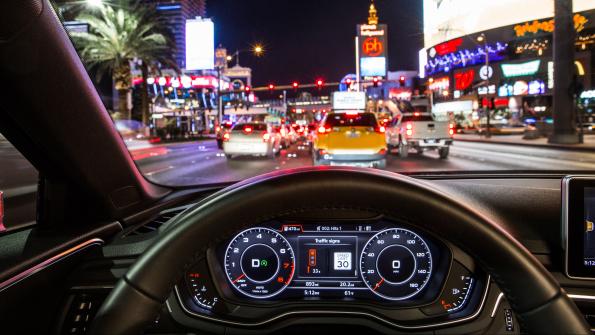Collaborating to create smart communities
Globally there’s a barrage of news and buzz about what it takes to be a “Smart City.” New advanced technologies are being developed, implemented and touted every day. In fact, smart city technology is advancing at such a rapid pace, many governments have created task forces or dedicated agencies to determine how best to leverage the latest advancements to benefit local communities.
However, because technology creates smart communities that break down boundaries and connect jurisdictions through intelligent infrastructure, trying to leverage those technologies on a local level could be counterproductive. Even metropolitan planning organizations (MPO) like the Regional Transportation Commission of Southern Nevada (RTC) must forge both public/private collaborations as well as multijurisdictional and intergovernmental partnerships to develop and implement forward-thinking plans that leverage technology. Improving the efficiency and performance of urban services, including transportation, takes a village, and enhances the quality of life regionally.
To harness the power of smart community technology, first understand the needs of the region and how specific technologies can provide solutions to meet those needs.
For example, the RTC knows Southern Nevada’s population is expected to grow rapidly. By 2025, approximately 30 percent and visitor volumes are projected to increase nearly 25 percent. This means that 53 million people will be coming to our region annually and relying upon the same infrastructure and services as its 2.7 million residents. This fast-paced growth poses significant challenges and opportunities – especially for a transportation system – to keep pace with the demands of more people, vehicles and goods needing to move safely and efficiently.
Regional solutions to local problems
To ensure Southern Nevada’s transportation infrastructure can keep pace, the RTC has embraced smart community technology that can provide regional solutions. The backbone of the solutions is a centralized intelligent transportation infrastructure that includes sensors, cameras and monitors accessed by technology companies – all leading to a developing massive data exchange to better inform planning and decisions.
Using that data, RTC, the Nevada Highway Patrol and Nevada Department of Transportation operates a centralized traffic management center. Instead of a patchwork of traffic management agencies, one operation unites all Southern Nevada’s jurisdictions into an integrated Intelligent Transportation System (ITS). As a result, it is easier for technology companies to partner with the regional players to test and deploy products that require connection to traffic signals, monitors and data.
By pursuing a modernized, integrated and unified intelligent transportation system, other communities can take better advantage of the various smart technologies being developed. These technologies can provide solutions to improve safety, increase capacity and reduce road congestion.
Cutting-edge technology
Embracing the regional approach, other communities can use technology to achieve those same goals. For example, RTC is employing the predictive services of Waycare to help identify where dangerous driving conditions on the road exist – before an incident actually occurs. Its system wirelessly integrates historical traffic data with real-time data, such as traffic light timing, major events, weather conditions, vehicle location, traffic speeds, and vehicle counts and occupancies to predict dangerous driving conditions. In Southern Nevada, the Highway Patrol and Nevada Department of Transportation use this information to more efficiently deploy law enforcement and roadside assistance units to patrol problem traffic areas. The RTC traffic management center uses Waycare’s real-time analytics to better optimize traffic flows.
At the same time, other technologies are being used to better inform drivers. A pilot project is outfitting RTC and Las Vegas vehicles with GENIVI Alliance infotainment software that provides alerts about nearby pedestrian activity, speeding, transit activity and roadway congestion. Drivers receive these alerts based on their vehicle’s location in relation to bus stops, crosswalks and local speed limits.
Another wireless technology, the Nexar app launched throughout Nevada earlier this year. It utilizes smartphone dash cams and wireless technology to provide drivers real-time alerts to prevent vehicle, cyclist and pedestrian collisions. The app records video outside a vehicle and measures vehicle dynamics related to speed, braking and turns. As a result, the app warns drivers to break for a hazard based on data from adjacent vehicles.
The company’s street level car-sourced information, including congestion, traffic patterns, infrastructure defects, road hazards and collision instances, is then shared with the RTC and local/state governments in real time. This car-sourced information helps improve infrastructure management, traffic optimization, roadway maintenance and regional transportation planning.
Southern Nevada also uses another cutting-edge technology, Audi’s “Time to Green” feature. In select Audi vehicles, the car communicates with Southern Nevada’s advanced traffic management system with driver alerts on the timing of upcoming traffic light changes. While impressive in its own right, this information is the first step to a truly autonomous vehicle. With this information, a driver could be provided speed recommendations to maximize the number of green lights made in a single sequence. At the same time, the RTC receives anonymous traffic signal timing data from the vehicle to help better manage congestion on crowded roadways.
Every community wants to reduce traffic congestion and increase safety, and smart technologies will obviously best advance these goals. The future of transportation for Southern Nevada – and communities across the United States – lies in the advanced technologies being developed today. Yet, their success is predicated on a collaborative approach to implementation. Cities, counties, and states will ultimately need to come together to develop the regulations and build the infrastructure required to enable smart community technology to move forward and drive our country into the future.
Larry Brown is Clark County Commissioner and Regional Transportation Commission of Southern Nevada Chairman.
_____________
To get connected and stay up-to-date with similar content from American City & County:
Like us on Facebook
Follow us on Twitter
Watch us on YouTube




















